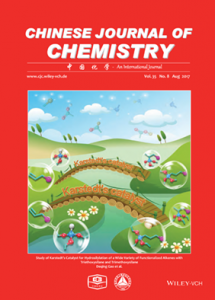 A 2011 chemistry paper required corrections so extensive that the author published the changes as a second, longer paper.
A 2011 chemistry paper required corrections so extensive that the author published the changes as a second, longer paper.
Both papers, published in the Chinese Journal of Chemistry, described the synthesis of a protein molecule with potential therapeutic applications in cancer. But when the paper’s corresponding author Yikang Wu tried to continue the work, he discovered that a substantial part of the 2011 study was incorrect.
The original paper is not marked with any editor’s note, even though the new paper — which is three pages longer than the 2011 version — acknowledges it is a “partial retraction/correction of previous results.” The new paper does appear in the list of “related content” for the 2011 article.
Given the errors, in the 2017 paper, Wu and his co-authors write:
obliged to retract part of the previous results to terminate any confusion that might have already been caused by the previous report and clarify the transformations involved therein through the new results.
The new 10-page paper, “On the Synthesis of Stereocalpin A: Partial Retraction/Correction of Previous Results and Rationalization of the Hidden Difficulties,” explains and revises the errors in the seven-page, “Studies Directed toward Synthesis of the Structure Proposed for Stereocalpin A.” The three-page difference arises from the papers’ experimental sections, which describe the synthesis and spectra of various compounds; the 2017 correction includes descriptions of eight more compounds than the original paper.
The abstract of the new paper, published online in April, briefly outlines the substantial issues in the original work:
In continuation/checking of a previous synthesis directed toward the literature structure of stereocalpin A it was found that the data for a substantial part of the intermediates reported before were incorrect. Some of the transformations were not successfully reproduced and the failures were shown to be consequences of the presence of the N-Me and the particular location of the ester linkage. The origins of the “extra/minor” signals in the NMR for most of the intermediates, which tend to be mistaken as signs for the presence of impurity/isomers, are also discussed.
The 2011 paper has been cited once, according to Clarivate Analytics’ Web of Science, by the new 2017 version. Wu—who works at the Chinese Academy of Sciences in Shanghai—is the only author listed on both.
In the new analysis, Wu and his co-authors try to understand what went wrong in the original paper and discuss the “hidden difficulties” of synthesizing the protein. The authors also explain that the purpose of the new paper is to correct the literature and to help other researchers “avoid undesired side reactions and understand the ‘unclean’ NMR spectra.”
The journal, however, has not yet explicitly marked the 2011 paper as corrected or partially retracted. We asked the editor how readers will know the 2011 paper has been corrected if it isn’t labeled or linked to the new paper, but he has not responded.
We recently covered a similar case of a chemist retracting a 15-year-old paper after discovering he had misidentified the key compound and subsequently publishing a corrected version. Although the journal did not label that as a retract and replace — an option some journals are using to correct honest but pervasive mistakes — the editor acknowledged that “essentially, this is what it is.”
We also asked the editor of Chinese Journal of Chemistry whether he would consider Wu’s case an example of a retract and replace; we will update the post if we hear back.
Like Retraction Watch? Consider making a tax-deductible contribution to support our growth. You can also follow us on Twitter, like us on Facebook, add us to your RSS reader, sign up on our homepage for an email every time there’s a new post, or subscribe to our daily digest. Click here to review our Comments Policy. For a sneak peek at what we’re working on, click here.
Stereocalpin A is not a protein, but a depsipeptide.
Fixed, thanks!
Almost! It appears once more in the second paragraph after the quote from the abstract.